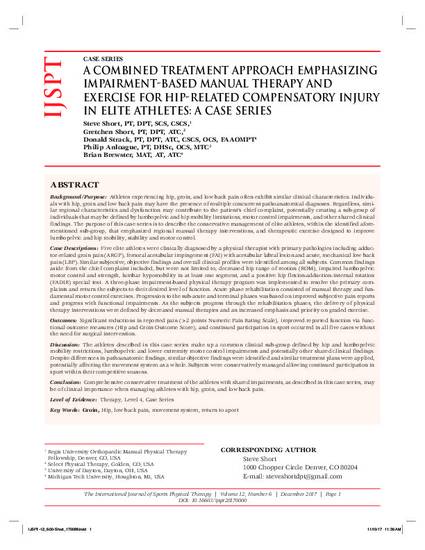
Article
A COMBINED TREATMENT APPROACH EMPHASIZING IMPAIRMENT-BASED MANUAL THERAPY AND EXERCISE FOR HIP-RELATED COMPENSATORY INJURY IN ELITE ATHLETES A CASE SERIES.pdf
The International Journal of Sports Physical Therapy
(2017)
Abstract
Background/Purpose: Athletes experiencing hip, groin, and low back pain often exhibit similar clinical characteristics. Individu- als with hip, groin and low back pain may have the presence of multiple concurrent pathoanatomical diagnoses. Regardless, simi- lar regional characteristics and dysfunction may contribute to the patient’s chief complaint, potentially creating a sub-group of individuals that may be defined by lumbopelvic and hip mobility limitations, motor control impairments, and other shared clinical findings. The purpose of this case series is to describe the conservative management of elite athletes, within the identified afore- mentioned sub-group, that emphasized regional manual therapy interventions, and therapeutic exercise designed to improve lumbopelvic and hip mobility, stability and motor control.
Case Descriptions: Five elite athletes were clinically diagnosed by a physical therapist with primary pathologies including adduc- tor-related groin pain (ARGP), femoral acetabular impingement (FAI) with acetabular labral lesion and acute, mechanical low back pain (LBP). Similar subjective, objective findings and overall clinical profiles were identified among all subjects. Common findings aside from the chief complaint included, but were not limited to, decreased hip range of motion (ROM), impaired lumbopelvic motor control and strength, lumbar hypomobility in at least one segment, and a positive hip flexion-adduction-internal rotation (FADIR) special test. A three-phase impairment-based physical therapy program was implemented to resolve the primary com- plaints and return the subjects to their desired level of function. Acute phase rehabilitation consisted of manual therapy and fun- damental motor control exercises. Progression to the sub-acute and terminal phases was based on improved subjective pain reports and progress with functional impairments. As the subjects progress through the rehabilitation phases, the delivery of physical therapy interventions were defined by decreased manual therapies and an increased emphasis and priority on graded exercise.
Outcomes: Significant reductions in reported pain (>2 points Numeric Pain Rating Scale), improved reported function via func- tional outcome measures (Hip and Groin Outcome Score), and continued participation in sport occurred in all five cases without the need for surgical intervention.
Discussion: The athletes described in this case series make up a common clinical sub-group defined by hip and lumbopelvic mobility restrictions, lumbopelvic and lower extremity motor control impairments and potentially other shared clinical findings. Despite differences in pathoanatomic findings, similar objective findings were identified and similar treatment plans were applied, potentially affecting the movement system as a whole. Subjects were conservatively managed allowing continued participation in sport within their competitive seasons.
Conclusion: Comprehensive conservative treatment of the athletes with shared impairments, as described in this case series, may be of clinical importance when managing athletes with hip, groin, and low back pain.
Keywords
- Groin,
- Hip,
- low back pain,
- movement system,
- return to sport
Disciplines
Publication Date
Winter December, 2017
DOI
10.16603/ijspt20170000
Citation Information
Philip A. Anloague. "A COMBINED TREATMENT APPROACH EMPHASIZING IMPAIRMENT-BASED MANUAL THERAPY AND EXERCISE FOR HIP-RELATED COMPENSATORY INJURY IN ELITE ATHLETES A CASE SERIES.pdf" The International Journal of Sports Physical Therapy Vol. 12 Iss. 6 (2017) Available at: http://works.bepress.com/philip_anloague/5/
